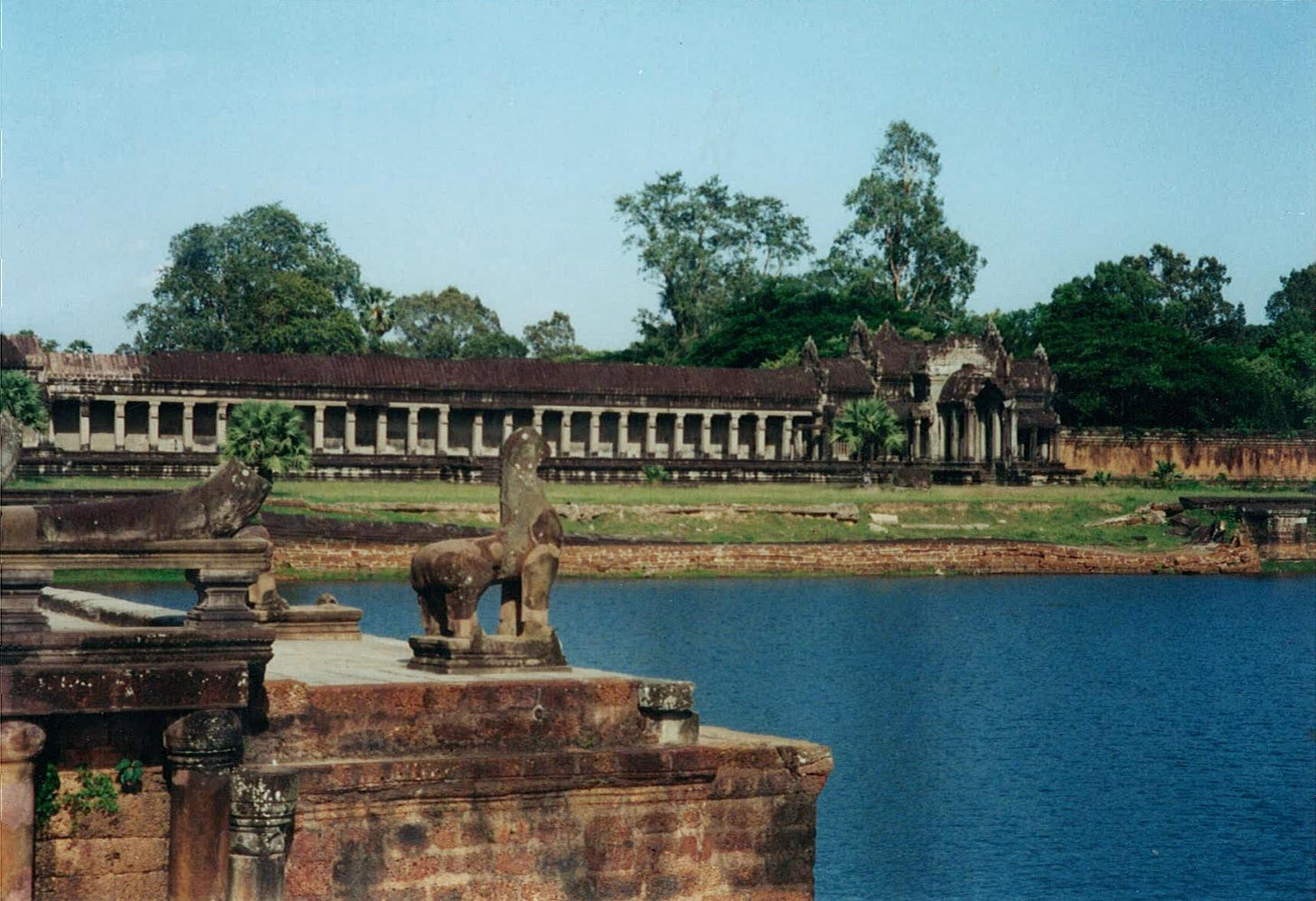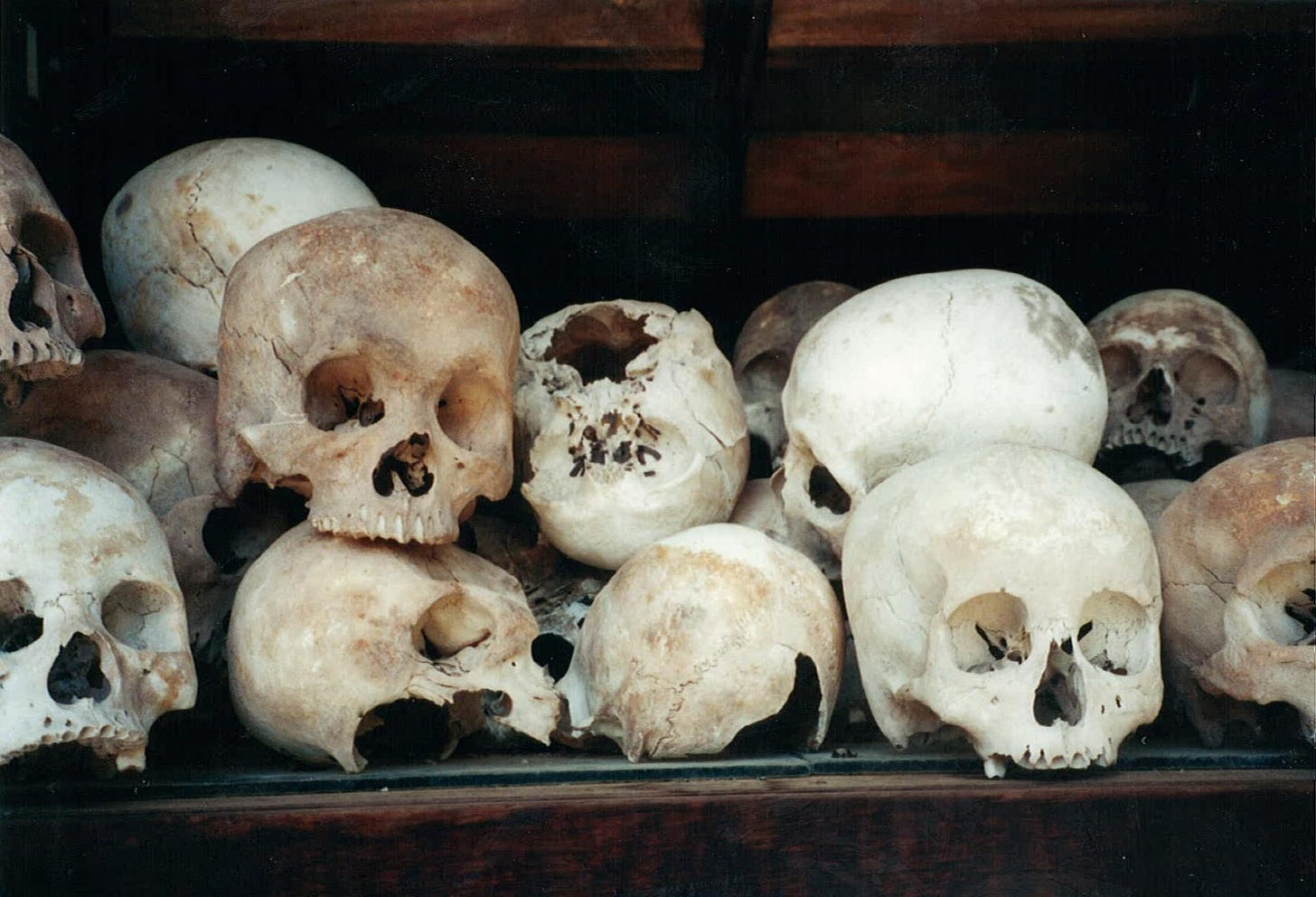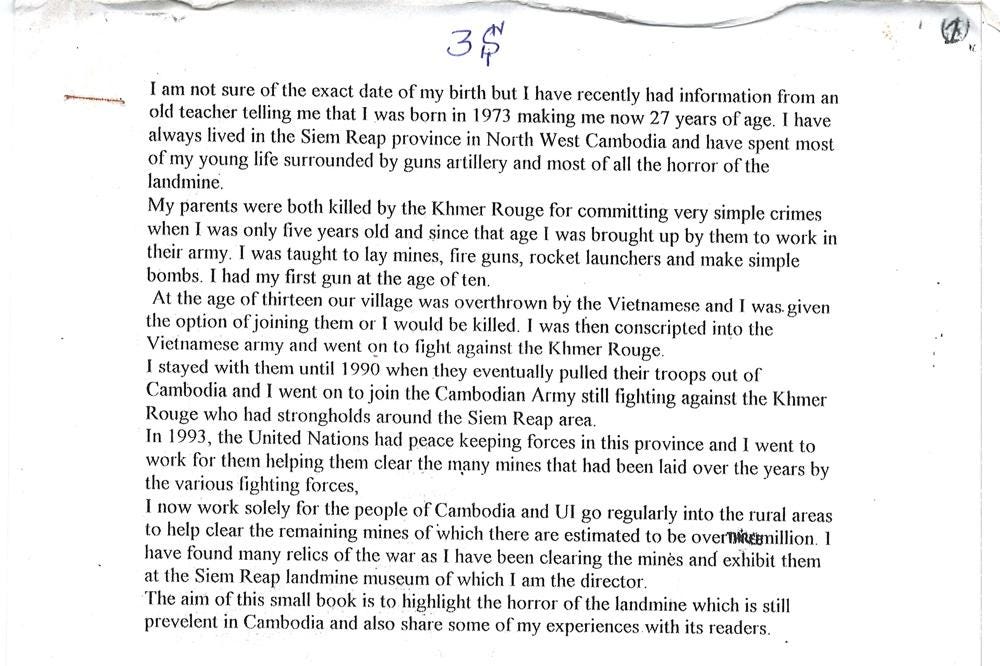Happy Saturday!
And welcome to another eclectic weekend. Apologies for the late running of this service; the rest of this week was taken up by the recording of Foiled and an ill-timed cold.
When, wringing my hands, I’ve despaired of ever finding this newsletter’s ‘niche’ topic, kind readers have replied by saying that, on the contrary, unexpected diversity is one of its main points of interest. This week’s story, I’m afraid, is thus typical of its kind.
Earlier this week, a friend of mine mentioned that she hoped to visit Thailand next year and asked me if I had any recommendations. I suggested Cambodia, which sent me down the white rabbit hole of my archives and reminded me of a child soldier turned landmine museum director who I met twenty years ago…
Read online: The $3 Stories of Mr Aki Ra (11 minute read)
The $3 Stories of Mr Aki Ra
Back in the summer of 2001, I spent a week exploring the temple complex at Angkor Wat. It was a short scooter ride from where we stayed in a village on the outskirts of Siem Reap.
Side note: For many years, I treasured an amber ring that my Cambodian scooter-guide had given me as a parting gift to celebrate our ‘marriage’—until a girlfriend accidentally, symbolically, smashed it, more, she protested, in play than in anger.
If you enjoy wandering around ancient ‘rems’ and wondering on the lives of our ancestors, then there is scarcely a better place on earth than the temples of Angkor.
But I’m here to talk about a more modern type of ruin.
All but essential
I was in Cambodia only a year and a half after the final surrender and dissolution of the Khmer Rouge—the party, led by Pol Pot, that perpetrated the genocide of about two million people in the 1970s.
Before I left the safety of Bangkok, my dad suggested that I look at the UK Government guidance on travel to Cambodia. It advised against all but essential travel.
My response was to rig up a DIY money belt, which promptly fell off in the streets of Phnom Penh, leaving me with no money and no credit card. The absurdity of this precaution was made embarrassingly apparent when I returned to Phnom Penh after my tour of the temples, and someone ran up to me in the street and handed back my wallet.
I haven’t paid much attention to UK Government advice ever since.
Nevertheless, the Cambodia I found in 2001 wasn’t exactly a haven of political stability. It was only three years since the death of Pol Pot. Two and half since two former Khmer Rouge generals made a ‘perfunctory’ apology for the genocide. And only two years since the capture of Ta Mok, the last of the unrepentant Khmer Rouge leadership, a man known prettily as The Butcher.
These final death throes of the Khmer Rouge genocidalists were overseen by Prime Minister Hun Sen, who himself only retained his position thanks to a coup d’état in 1997. Incidentally, but perhaps not surprisingly, Hun Sen still holds the reins of power.
In 2001, it was in no way obvious that Cambodia would steer clear of the violence that characterised so much of the history of the region in the twentieth century.
World War II: the forgotten 45 years
Geographically, Cambodia is cradled for over 1,000km by her neighbour, Vietnam. Only 200km separates the capital of Cambodia, Phnom Penh, and Vietnam’s most populous city, Ho Chi Minh City.
The Vietnam War is well remembered in the West because of the tragic invasions and occupations of the French and US militaries between 1946 and 1975.
Cambodia is the forgotten victim here: between 1969 and 1973, the US Airforce dropped at least half a million tons of bombs on the country, making it ‘one of the most heavily-bombarded countries in history’, exceeding the Allied bombardment of Germany during World War Two.
But just because exogenous armies eventually left Vietnam and Cambodia, doesn’t mean that violence in the region was over, merely that what followed is less well remembered—despite this next phase of conflict matching or even exceeding the Vietnam War casualties.
In 1975, the Khmer Rouge took control of Cambodia and launched their systematic genocide. In 1978, the Vietnamese military invaded. A ceasefire was only agreed in 1991—well within the bounds of living memory for this author, and a mere ten years before my visit to the country.
For Southeast Asia, the Second World War didn’t end until Bryan Adams was top of the charts and another four million people had died.
The horror of the conflict is remembered at the Cambodian Landmine Museum, set up on the outskirts of Siem Reap City by a former child soldier, a man who fought on all sides of the war and who now works clearing the mines he once helped to lay: Mr Aki Ra.
Introducing Mr Aki Ra
I confess that I was in Cambodia for ancient history, not bleeding history. But one evening, in the garden of the small guesthouse where I was staying, I got chatting to a young couple, who urged me to take a trip into the more recent past and to visit Mr Aki Ra.
Mr Aki Ra opened his museum in 1999 and filled it with all the military junk that he found while clearing some of Cambodia’s untold millions of landmines.
I had many guns such as AK47s, Kalasnikovs, M16s, M60s, small pistols, machine guns and large rifles. I had rocket launchers, mortars, grenades, gas masks, CS gas canisters, bombs and even uniforms. On one occasion, I found napalm but it was too heavy for me to carry alone so I had to leave it.
Surrounded by his collection of decommissioned weaponry, Mr Aki Ra offers visitors an inconvenient juxtaposition to the peace and tranquillity of the monuments of Angkor.
I have always lived in Siem Reap province in Northwest Cambodia and have spent most of my life surrounded by guns, artillery and most of all, the horrors of the landmine.
Not long ago, he explains, the temples we coo over were live military bases. The Khmer Rouge held the famous jungle-invested Ta Prohm, while the Vietnamese set up in Angkor Wat itself.
The Vietnamese were responsible for destroying many of the precious statues in and around the Angkor Wat area as they used to take potshots at them when they were bored. They looted many ancient and valuable artifacts from the temples and they have never been found.
Suitably chastened, I paid $3 for a stapled-together 17-page pamphlet of Mr Aki Ra’s stories. It’s those stories that I’d like to share with you today, finally fulfilling a promise that I made twenty years ago.
The $3 stories of Mr Aki Ra
After both his parents were killed when he was about five years old, Aki Ra was brought up as an orphan soldier of the Khmer Rouge. Everyone lived in a state of ‘virtual starvation’ and Aki Ra remembers sneaking out of camp to catch insects to eat.
It was a midnight feast that not everyone survived.
My friend went to the pig trough and stole some scraps and quickly ate them. The next morning, when the Khmer Rouge were carrying out their usual faeces check, they noticed that one lot was different from the others and asked who it belonged to. My friend said that it was the pigs, but there were tell tale child’s footprints beside it and the Khmer rouge accused the child of lying and killed him.
Villagers were encouraged to betray their neighbours and those accused of any petty crime ‘would have their throats slit very slowly with palm fronds’ while the rest of the village was forced to cheer and clap the murder.
To the Khmer Rouge, life was cheap and they did not care who lived or died during their years of brutality.
Primary education
When he was about ten, the Khmer Rouge gave Aki Ra his first AK47, a weapon almost bigger than he was. He was also taught how to fire rocket launchers, lay mines and make simple bombs.
In a way, these weapons were like toys to us children and we used to play games with them. Some small children were not familiar with guns and the Khmer Rouge would give them loaded guns with the safety pin off. One of my friends shot himself in the head accidentally because he did not understand how the gun worked.
The Khmer Rouge taught Aki Ra only one letter of the Khmer alphabet per week.
They had my innocence in their hands and were able to warp it any way they chose. I thought that the whole world existed like we did and the brutality and hardship, the starvation and all the guns, became my normal world.
At an age when I was making the transition from Primary to Secondary School, Aki Ra was captured at gunpoint by the Vietnamese army and conscripted to fight his former overlords.
Secondary education
By this time, both the Vietnamese and the Khmer Rouge armies were desperate for recruits and started to treat people better. The Vietnamese promised Aki Ra good food and money, as well as rank and power.
But life with the Vietnamese wasn’t so different: the soldiers were still hungry, constantly scratching around for food. Many times, Aki Ra would have to pee into a bag of rice to soften the grains for eating.
At this point, I still knew nothing of what was going on the outside world and continued to imagine that this kind of life was normal.
When he was fourteen, Aki Ra’s unit found themselves outnumbered by Khmer Rouge fighters and had to run for their lives.
While we were running, we dropped ammunition from the magazines of our AK47s onto the ground. These appeared to be loaded with ammunition. However, we had added poison to the bullets so that when the guns were consequently fired, they would give off a toxic gas. We later returned to find the Khmer Rouge choking on the poisonous fumes and we killed them all.
There were no rules of engagement: each side did whatever they must in order to kill and survive.
I was very lucky during all my time spent with the various different armies and had many lucky escapes.
Learning a trade
In 1993, a United Nations peacekeeping force arrived in Siem Reap and Aki Ra answered their call for people to start clearing the fields of landmines. He remembers his astonishment on visiting Siem Reap city for the first time:
When the UN put a huge cinema screen up in the town, the people came to wonder at the film. When the cars and tanks moved on the screen, many people ran away as they thought that they were going to come right off the screen into the audience.
Landmines were used on both sides of the war in Cambodia and, being small and light, were especially suited for armies of child soldiers.
Many people between the years 1984 and 1990 were killed or injured by landmines. The hospitals were far away and there were few civilians or soldiers who had first-aid knowledge to help.
The quantity of unexploded ordinance left in the country is hard to even estimate. In the first six months of 2020, according to the Cambodian Mine Action Centre, more than 20,000 explosive devices were found and destroyed.
In his stories of landmine explosions, Aki Ra paints a picture of terrifying randomness, tragially paired with desperate corruption.
It was […] common for villages to have to make huge payments to the Vietnamese army, if a family member or their animals stepped on and detonated a mine.
A landmine explosion is usually enough to rip off a leg, but often not enough to kill someone. If the victim survives, then they face a lifetime of torture—not only from the physical wounds, but from the wounds inflicted by society.
Many of the soldiers who were victims of mines were evicted from the army and then left to find badly-paid jobs, such as road cleaning. Many resort to begging to this day.
Making this country safe for its people
Since the 1990s, Mr Aki Ra has had only one ambition in life: to make his country safe for its people.
There are still hundreds of people killed or injured every year by landmines, many of them civilians working in the fields who come across them while clearing the land.
Profits from Aki Ra’s museum go towards funding his landmine clearance NGO and supporting children who, like him, have become orphans.
Despite an ambitious government target for the country to be landmine-free by 2025, Aki Ra thinks it will take 50-100 years to find and clear every single mine.
You can help us by informing people in your country about the problems we face in Cambodia and hopefully we will eventually get enough support to assist us to speed up making this country safe for its people.
In 2018, Mr Aki Ra was arrested and the museum shut down. Despite his protests that the weapons were all perfectly safe, the authorities suspected that he was building a private arsenal.
Luckily, he avoided a conviction and I’m pleased to report that, today, Mr Aki Ra is still out there, clearing landmines.
~
You can read more of Mr Aki Ra’s stories on the website of his NGO: Cambodian Self Help Demining.
Any more for any more?
I enjoyed this episode of the Talk Easy podcast, with historian and philosopher Rutger Bregman. Bregman argues that, individually, we aren’t a particularly competent species, but we excel when we work together and collectively build on the slightly incompetent advances of other humans. Thus does Bregman rephrase Sir Isaac Newton: we’re not ‘standing on the shoulders of giants’; we’re ‘standing on the shoulders of dwarfs’.
If you like, you can read this Guardian article about wildflower verges as a hopeful metaphor:
“As fertility declines in a soil, biodiversity increases. At first that seems a little counterintuitive because you imagine the more you pour into a soil, the more plants that can grow. That’s not how it works in the natural system. In more fertile systems, a few species dominate and they swamp and smother everything else.”
Hibiscus tea. Delicious. And good for you, apparently. That is all.
With Foiled Series 4 ‘in the can’, I’m preparing for an exceedingly long walk. The (vague) plan is to hike the full length of the Cotswold Way, plus a bit further, to connect the first two of T.S. Eliot’s Four Quartets: Burnt Norton and East Coker.
At 160 miles, it’s by far and away the longest (and most pretentious) of my Christmas walks and, if accomplished, should take 8-10 days. Which makes me suspect that it won’t be accomplished, at least not all in one go.
Whatever happens, I’m looking forward to a chunk of Thoreauvian therapy in nature, reflecting on time past and time future, away from the false allure of the screens that T.S. Eliot seemingly foresaw:
Only a flicker
Over the strained time-ridden faces
Distracted from distraction by distraction
Filled with fancies and empty of meaning
Thanks to EF for sending me that quote! I wish you a wonderful week, and hope to drop into your inbox again next Friday—should our paths allow.
Big love,
dc:
CREDITS
Hello, I’m David Charles and I wrote this newsletter. I publish another newsletter about reading called Books Make Books. I’m co-writer of BBC Radio Wales sitcom Foiled, and also write for The Bike Project, the Center for International Forestry Research and Thighs of Steel. Reply to this email, or delve into the archive on davidcharles.info.
Unlock the commons for £30
These free weekly newsletters are currently 7.8 percent funded. You can unlock the commons for everyone forever (or at least until the Internet falls asleep) by becoming a paying subscriber from £30 per year—that’s 58p per newsletter. I donate 10 percent to help promote equality and justice. Thank you.






